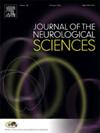血浆尿酸水平与痴呆风险:一项基于人群的队列研究
IF 3.6
3区 医学
Q1 CLINICAL NEUROLOGY
引用次数: 0
摘要
背景:鉴于尿酸(UA)的相反特性,即细胞内的促氧化作用和细胞外的抗氧化作用,循环尿酸水平与痴呆的关系仍然存在争议。我们的目的是确定中老年人群中低和高血浆UA水平是否与痴呆发生风险相关。方法在基线(1990-1993)时,随机选择年龄在40-69岁之间的1685名参与者(530名男性和1155名女性)进行血浆UA测量,这些参与者均回答了基线问卷并提供了血液样本。他们被跟踪调查痴呆症(需要护理的致残性痴呆症;2006年至2016年使用日本国家长期护理保险认证记录。Cox比例风险模型校正了各种生活方式因素和既往病史(心脏代谢疾病),适用于所有参与者和性别。结果240名参与者被诊断为痴呆(总体14.2%,男性16.0%,女性13.4%)。在所有参与者中未发现与血浆UA有统计学意义的关联。与UA为5.1-6.0 mg/dL的参与者相比,≥6.1 mg/dL的男性6.1 - 7.0 mg/dL的完全调整风险比为1.46(95%可信区间:0.78-2.75),≥7.1 mg/dL的1.89(0.97-3.66),而≥6.1 mg/dL的女性为1.13(0.54-2.38)。结论血浆UA水平与痴呆风险之间在总体参与者或性别中均无统计学意义的关联。本文章由计算机程序翻译,如有差异,请以英文原文为准。
Plasma uric acid levels and risk of dementia in a population-based cohort study
Background
Given the opposing properties of uric acid (UA), which are intracellular prooxidant action and extracellular antioxidant action, the association of circulating UA levels with dementia remains controversial. We aimed to ascertain whether both lower and higher plasma UA levels are associated with the risk of incident dementia among middle-aged and older population.
Methods
1685 participants (530 men and 1155 women) aged 40–69 years at baseline (1990–1993) were randomly selected for plasma UA measurement from base cohort participants who responded to the baseline questionnaire and provided blood samples. They were followed for dementia (disabling dementia requiring care; hereinafter dementia) from 2006 to 2016 using certification records for national long-term care insurance in Japan. A Cox proportional hazards model adjusted for various lifestyle factors and past medical history (cardiometabolic disease) was applied for overall participants and sex.
Results
Dementia was diagnosed in 240 participants (14.2 % overall: 16.0 % in men and 13.4 % in women). No statistically significant association with plasma UA was found in overall participants. Compared to participants with UA of 5.1–6.0 mg/dL, men with ≥6.1 mg/dL showed fully adjusted hazard ratios of 1.46 (95 % confidence interval: 0.78–2.75) for 6.1–7.0 mg/dL and 1.89 (0.97–3.66) for ≥7.1 mg/dL, while women with ≥6.1 mg/dL showed 1.13 (0.54–2.38).
Conclusions
No statistically significant association between plasma UA level and risk of dementia was found in overall participants or by sex.
求助全文
通过发布文献求助,成功后即可免费获取论文全文。
去求助
来源期刊

Journal of the Neurological Sciences
医学-临床神经学
CiteScore
7.60
自引率
2.30%
发文量
313
审稿时长
22 days
期刊介绍:
The Journal of the Neurological Sciences provides a medium for the prompt publication of original articles in neurology and neuroscience from around the world. JNS places special emphasis on articles that: 1) provide guidance to clinicians around the world (Best Practices, Global Neurology); 2) report cutting-edge science related to neurology (Basic and Translational Sciences); 3) educate readers about relevant and practical clinical outcomes in neurology (Outcomes Research); and 4) summarize or editorialize the current state of the literature (Reviews, Commentaries, and Editorials).
JNS accepts most types of manuscripts for consideration including original research papers, short communications, reviews, book reviews, letters to the Editor, opinions and editorials. Topics considered will be from neurology-related fields that are of interest to practicing physicians around the world. Examples include neuromuscular diseases, demyelination, atrophies, dementia, neoplasms, infections, epilepsies, disturbances of consciousness, stroke and cerebral circulation, growth and development, plasticity and intermediary metabolism.
 求助内容:
求助内容: 应助结果提醒方式:
应助结果提醒方式:


